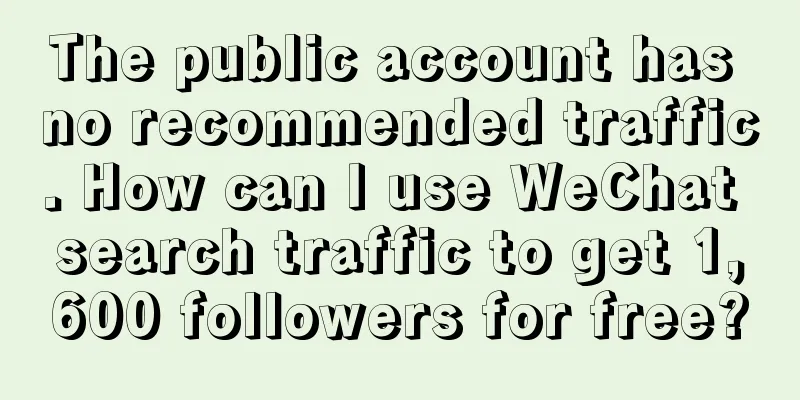Don’t use private domain traffic to explain everything anymore

………… Everyone is collectively trapped in a period of confusion in the private domain. There is no substantial change in the operation, but the entanglement is only to miss the window of opportunity again and again. The more confused we are, the more we should return to the natural logic and find the answer to the problem. 1. Stop using “private domain traffic” to explain everythingWhen the concept of "private domain traffic" was first proposed, it had never been truly explained, resulting in many misunderstandings among brands and companies about "private domain". Everyone is talking about private domains. Most brands simply and crudely think that they should first attract potential customers and then operate them. Because they don’t understand the essence, they still use “private domain traffic” to summarize it. Some views need to be corrected and clarified. After all, traffic is generated in the public domain, which is a large and vague data measurement, because the face of the individual unit - "people" is vague or even indistinguishable. In the private domain, "people's" consumption habits and preferences can be sedimented... Therefore, it is no longer a unified concept, but a circle that needs to be segmented and specially maintained. In addition, in a public domain environment, the contact between brands and users is often one-time, and there is no talk of establishing a relationship with users. In the private domain, users are selected from the traffic by themselves or are attracted and screened. They enter a brand pool because of their interests and intentions. Only by capturing these people can the brand generate a steady stream of customers. Therefore, using "private domain traffic" to explain all business problems actually does not truly understand the difference between public and private domains. It is time to re-examine these concepts and have a clear understanding. After all, enterprises and brands have entered the stage of competing for existing resources and refined operations. Defining private domain only from the perspective of traffic may miss the opportunity for real business growth. 2. The truth! The storm of “global management” is comingThe explosive growth in private domains is actually a harbinger of the coming storm of “full-domain operations”. The core way for enterprises to achieve omni-domain operation is to operate the public and private domains together. In order to help retail enterprises better understand the overall situation of the public and private domains and find the most suitable independent operation path for their own development, the China Chain Store & Franchise Association (CCFA) and Tencent jointly launched the "China Retail Public and Private Domain Operation Manual and Implementation Guidelines", which comprehensively analyzed the public and private domains for the first time and provided directional guidance for the industry. Several of the definitions are very interesting and effectively clarify several key sectors in the public and private domains. The public-private domain panorama has four components:
It is not difficult to see that the difference between private domain and public domain lies in whether the merchant has the autonomy to repeatedly reach out to users at low cost or even for free. This is a concept corresponding to public domain traffic. The two terms "traffic" and "user" are opposite, reflecting the difference between public domain traffic thinking and private domain user thinking. This often makes us tend to think that the purpose of public-private domain interoperability is to focus more on the private domain, but in fact, public-private domain interoperability is to provide customers with integrated online and offline services and experiences through product strategies and operation strategies in different domains. Taking water from the public domain and providing access, storing water in the private domain and providing services, maximizing business value, the center of the storm of business model transformation is always in the "whole domain" of public-private transport. 3. Short term: Changes in customer relationshipsAs the trend of “omni-domain management” blows by, brands need to rethink how brand strategies and marketing methods need to change to cope with different environments in the public and private domains. In the short term, the most direct change is in customer relationships. In the public domain - the relationship between brands and customers is often purely sales-oriented. Brands’ sales relationships in the public domain are basically fixed. In terms of channels, the positions of online shelf-based e-commerce platforms such as Tmall, JD.com, and even Pinduoduo, live-streaming e-commerce platforms such as Douyin and Kuaishou, and offline new retail stores, self-operated stores, and large shopping malls are basically fixed. With the budget basically unchanged, the quantity of goods sold is limited and random, and the relationship between users and brands remains at a silent level with almost no opportunity for dialogue. Even if manual conversion is completed through seed marketing, pre-sales services, etc., the service cycle of brands for users is still relatively short. The overall structural status of sales personnel is not high, and they mainly recommend and convert based on the consumption habits and mentality of users. In the private domain, the relationship between brands and customers is often highly complex. This complex relationship is reflected in the fact that in addition to sales, the brand will form various relationships with customers, such as secondary purchases, information, and after-sales service. Therefore, almost every employee of a company or brand can become a sales portal. Social networks, personal connections, offline marketing, online memberships... There are too many channels for traffic distribution, but they are all gathered under the umbrella of "brand", which allows the brand to extend its service cycle to users indefinitely. This requires brands to use different methods to activate private domains and more professional operators to accumulate brand digital assets. No matter which one, what you are managing is the customer relationship. Building brand trust and shaping brand personality may be the new growth of the brand, and this new growth will bring new business imagination to the brand. 4. Medium term: Changes in the organizational systemThe user relationship is different, and the organizational system will definitely change accordingly. In the environment of global operation, the organization needs to change as a whole to achieve adaptation from head to toe. This is a mid-term change, which requires companies to make adjustments in the process of continuous experimentation, rather than blindly "doing it all in one go" and causing waste.
In a word, brothers should settle accounts clearly and stand firm before starting again. 5. Long term: Changes in business philosophyThe superstructure determines the economic base. In the storm of global operations, the business philosophy of an enterprise is equivalent to the captain's sense of direction. If it does not change or update, it is likely to fall into trouble or even run aground. There are three rare perspectives worth sharing: 1. Get out of the low-profit product promotion trapBrands need to be aware that simply bringing in goods and simply increasing sales may just be "ineffective operations" and that a low-profit model driven by "effects" may just be a trap for bringing in goods. Traffic comes in and goods are sold, but the brand does not make money or retain employees, and ends up losing both money and people. 2. Controllable positions, controllable traffic and controllable costsDoing business in the private domain is not blind investment, it is a "controllable position" compared to the public domain. Traffic is controllable. The size of the private domain determines the size of the traffic. Costs are also controllable. The cost of attracting traffic and activation costs are almost clearly marked. Unlike the public domain, which is full of randomness, global operations require "control". 3. Muscle growth instead of fat growthA large but inappropriate surge is actually useless. No matter how fast the volume grows, if it cannot be controlled, it is just a piece of fat that is difficult to use for the brand, and fat cannot be converted into muscle at all, it will only become a burden on the operation of the company. We need controllable muscle, not useless fat. 6. Run first, run first, run firstThe core links of global operations are actually very unified. No matter how different the characteristics and models of the sub-sectors are, there are three key steps that are basically the same: Privatization of public domain traffic, operation of private domain user pool, and overall commercialization of private domain. This is the starting point of global operations. No matter what the purpose is or what great undertakings are, these three steps are required. For enterprises, the key is to get running first. Here are a few examples of using different private domain stores and conversion tools: 1. Joyoung: Mini Program Matrix Carrying Contact PointsJoyoung has integrated offline scenarios such as product registration, extended warranty services, and manuals into the "Joyoung Home" applet, and used it as the core service traffic entrance. Specifically, the "Joyoung Sunshine Service" applet provides users with one-stop worry-free after-sales service; "Love Cooking Lite" is built into a food content service position, deeply cultivating high-quality content in vertical scenarios; the "Joyoung Dealer" applet matrix empowers stores and becomes a conversion position and membership club for offline stores. As a unified purchase conversion platform for online traffic, the "Joyoung Mall" mini program takes over traffic from various touchpoints for transaction conversion. At the same time, it combines the operation of the membership system and points mall to achieve the retention and activation of high-value members, bringing about a long-term and stable increase in private domain GMV. Focusing on users, Joyoung has built a complete mini-program matrix. Through services, content, membership, purchase, etc., it has turned offline traffic online and public domain traffic into private domain, completing a self-closed loop from traffic generation, retention to repeat purchase, and improving overall operational efficiency. 2. Nayuki’s Tea: Repeated reach through WeChat public accountsNayuki Tea is known as the "first stock of new-style tea drinks". Based on its deep understanding of the WeChat ecosystem, it uses official accounts as the main online private domain and as the core channel to repeatedly reach users. Its growth team will carefully label the traffic to the store and distribute different rights and benefits packages to different consumers through official accounts, realizing a one-size-fits-all operation. So far, the number of users of Nayuki’s official WeChat account has reached 8 million. Relying on WeChat official accounts to carry out the design of public-private domain linkage has two major values for brands. On the one hand, it can serve as an online sedimentation of public domain traffic, and obtain a preliminary pool of new private domain users every month; on the other hand, the official account can be used as a private domain user pool to promote the activation and frequency of private domain users. During the testing phase alone, "Follow and Get Gifts" achieved hundreds of thousands in revenue. 3. Chao Hongji: Video account live broadcast links public and private domainsIn public domain live streaming, there are few companies that can achieve results with a unit price of more than 5,000 yuan for goods. However, Chow Tai Fook has successfully achieved a breakthrough through mini-program cloud stores and video account live streaming. In the live broadcast of its "2021 Color Gold Fashion Trend Conference", Chow Tai Fook activated regional and store resources in advance, transferred offline traffic to the live broadcast room, and matched and prepared new national trend products with high spreadability. At the same time, in order to maximize the flow of traffic and achieve efficient conversion, Chao Hongji also provides a rich pool of products - from flash sales of hundreds of yuan to jewelry within 2,000 yuan, from main sales or new products priced from 2,000 to 8,000 yuan, to high-priced loose diamonds and high-end inlaid jewelry around 30,000 to 50,000 yuan, for users to choose from. Among them, the high-priced loose diamond products of 15,000 yuan have the highest sales volume and are recognized by users. Chow Tai Fook believes that a shopping guide’s understanding of users and value management must be continuous and long-term, and that the right products and content must be pushed to the right people. 4. WonderLab: WeChat for Business connects usersWonderLab, a new brand of nutritious meal replacement food, found in a survey that users of the mini program private domain have a high degree of trust in its brand, recognize the healthiness of its products, and have a strong willingness to repurchase. However, due to busy life and work, they tend to forget to repurchase after the product is consumed. This discovery led them to look for tools that can carry mini programs and achieve precise dialogue operations. This is why WonderLab has strengthened its WeChat business operations. For new users, they use WeChat business to add their personal WeChat accounts, provide 1v1 guidance, and provide in-depth user care. They also accelerate their conversion into loyal customers by giving away gift samples. After users complete their first order, WonderLab will also add related product displays and recommendations on the relevant pages to attract them to buy again. WonderLab has built a long-term brand operation position by continuously obtaining user feedback and adjusting operational SOPs such as 1V1 targeted services, and continuously strengthening brand exposure in various public and private channels to awaken and recall users in a timely manner. 5. Yanli: WeChat community service enhancementYanli, a direct-sale chain brand of imported cosmetics, relies on WeChat communities to provide users with professional pre-sales and after-sales services, effectively improving user satisfaction. Initially, Yanli built communities based on stores. After the number of users continued to increase, it began to establish separate communities based on brands and regions, such as Japanese brand groups and French brand groups, to ensure that users in the community have similar needs. Yanli's own beauty consultants work with brands to respond to users' pre-sales questions and usage issues in the community in a targeted manner, gaining user trust and significantly increasing repurchase rates. … In the public-private domain interoperability chain, the private domain is a catalyst for conversion and transactions. It can also cultivate users' long-term trust in the brand, provide full life cycle services, and bring about continuous transactions and repeat purchases. Improving private domain capabilities is a key link in the growth of overall business performance. There are countless similar cases, and the essence is to continuously meet the relationship operation and consumption needs of users throughout their life cycle. In practical application, private domain stores have opened up new sales service scenarios and increments based on the public domain traffic platform, and use private domain stores as a new consumption carrier after users leave the store or when the store is closed. 7. Good news: an increasingly open Tencent ecosystemWeChat can now open Taobao links, and Taobao will probably also be able to support WeChat payments soon. The ecological barriers built by major Internet companies are collapsing. From the micro perspective of individual enterprises, the entire Tencent ecosystem is becoming more and more open, which is a good thing. As the creator of a national-level social application, Tencent naturally spans public and private domains: the WeChat ecosystem, QQ ecosystem, enterprise WeChat ecosystem and even the entire Tencent ecosystem can all serve as channels and tools for global operations. In concrete terms, brands use advertising or natural traffic fission to divert traffic from the public domain, and transfer it to the private domain user pool by adding fans to official accounts and adding shopping guides. They also divert traffic and conversion by continuously reaching users through official accounts, communities, and Moments, and ultimately obtain transactions through the brand's private domain stores such as mini programs, H5, live broadcast rooms and other channels. This cycle repeats itself and the user's full life cycle value is obtained. To be honest, before 2020, the question that brands discussed was, "Should we do private domain?" However, after the actual operation in 2020, everyone's question has changed to "How to do private domain?" This means that now that the infrastructure has been completed, the private domain transaction ecosystem will have the opportunity to usher in a large-scale explosion, and there will be more and more private domain economies with a scale of tens of billions, such as Xingsheng Youxuan. Take WeChat as an example. WeChat is more like an ecosystem, a forest. Enterprise WeChat, video accounts, public accounts, mini programs... are all environmental elements in this forest, which can support the free growth, migration and settlement of animals and plants. Brands form their own small circles of self-circulation and serve as part of the forest's maintainers. There are forests outside of forests. How to expand the scope of their own forests and make them more livable is a problem that brands must face. In 2022, the curtain of "full-area operation" has just been opened. Author: Jing Xun Source: WeChat public account "Party A Finance (ID: jiafangcaijing2019)" |
<<: The dramatic copywriter of PX Mart is so good at having fun!
>>: How to create a million-level virtual anchor from 0 to 1?
Recommend
7 Questions about Live Slicing
Does "live slicing" make money? What iss...
The "huge wealth" of bees and flowers cannot be achieved by relying solely on free traffic
As the Li Jiaqi incident continued to ferment, tra...
How to deal with Amazon's over-age inventory? What are the methods?
There are many situations that merchants do not wa...
MINISO, addicted to collaborations, has turned itself into a "toy store"
As the retail industry continues to change, MINISO...
How to set up a Shopee add-on discount? Which products are suitable for add-on discounts?
Increasing the add-to-cart feature on the Shopee p...
Some thoughts for June 2023!
This article shares the author's insights on m...
The copywriting written by AI won an award!
The AI novel "The Land of Machine Memories&...
City Walk, which is popular all over the Internet, has a tea brand that has driven sales of 12 million?
As a hot lifestyle trend among young people, how s...
Creativity or delusion? Don’t panic when facing AI hallucinations
Recently, Xiao Ai captured the guessed answer by s...
Is there a distribution market for Shopify stores? How to do Shopify distribution?
Shopify is a very powerful website building tool. ...
After 9 years of operation, how do I understand "user growth"?
Editor's note: In this article, the author sha...
Fighting against the "AI flavor", can AI really write "online articles" with a stable style? | AI writing software
This article explores the application and limitati...
There is a solution to the chaos of excessive filters in influencer marketing!
A proposal recently submitted by France requires i...
Taobao Live’s mentality has changed
Behind the model of connecting and getting along w...
Live e-commerce "kills" 618
Under the general trend of the integration of cont...









